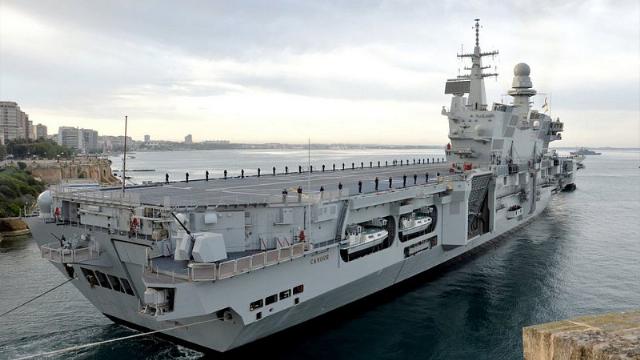In 2026, Italy will begin developing a feasibility study for the Portaerei di Nuova Generazione project, a new generation aircraft carrier that could become the first ship in the Italian navy with a nuclear power plant.
According to Navy Recognition, the new platform can also receive electromagnetic catapults of the EMALS type and advanced cyber-secure control systems.

Aircraft Carrier Cavour, Italian Navy
Italian Navy
Admiral Enrico Credendino, Chief of Staff of the Italian Navy, confirmed that the design of a nuclear-powered aircraft carrier is being considered as part of the Navy's strategic plan until 2040. He also explained that all new ships of the Italian Navy will be designed taking into account the integration of unmanned systems and enhanced cyber defense capabilities.
Fighters for the future aircraft carrier have not yet been selected: options are being considered from the modification of the F-35C to the next-generation carrier-based combat aircraft F-A/XX, which is just beginning to be developed in the interests of the US Navy. The British initiative to develop an advanced fighter aircraft, the Global Combat Air Program (GCAP), is also not discounted.
Currently, Italy operates two aircraft carriers: the aircraft carrier Cavour, commissioned in 2009, and the universal amphibious assault ship Trieste, which entered service at the end of 2024. Both ships are adapted for operations with shortened takeoff and vertical landing (STOVL) aircraft. The Trieste's 230-meter flight deck allows it to serve as a backup aircraft carrier, especially during scheduled maintenance of the Cavour.
As part of the Minerva program, officially launched in 2023, the Office of Naval Armaments of the Italian Ministry of Defense is exploring the possibilities of using nuclear energy on advanced naval ships. The first stage of the program includes a feasibility study for the integration of next-generation naval nuclear reactors. At the second stage, a conceptual design of a nuclear-powered warship is planned. The third stage involves a comparative assessment between an existing ship with a traditional power plant and a similar ship based on a nuclear reactor.
The general contractor for the project is Fincantieri, which cooperates with a number of other Italian companies – Cetena, Ansaldo Nuclear and Rina Services, as well as with the University of Genoa.
Launched in May 2025, the Nuclitalia program, with the participation of Enel, Ansaldo Energia and Leonardo, aims to evaluate advanced nuclear technologies for both civilian and military applications, with a focus on small modular water-cooled reactors.
The Italian Navy's interest in nuclear energy has historical roots. In 1959, Admiral Ernesto Giuriati proposed building nuclear attack submarines. Guglielmo Marconi designed a 3,400-ton submarine using a 30-megawatt reactor, which was going to be created on the basis of American analogues.
The development of the reactor was entrusted to CAMEN, an interagency center established in 1962 for military nuclear applications. However, the project was abandoned after 1963, when the United States ceased technical cooperation. Officially, the decision was justified by a legislative ban on the export of military nuclear technologies. The real motives were NATO's strategic constraints after the Caribbean crisis and political concerns about the Italian Communist Party.
A subsequent attempt to obtain technological assistance from France also failed. Although the keel of the submarine has already been laid, the program was closed.
